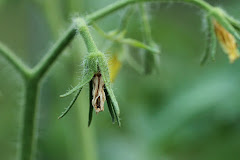It is often said that spring freezes are the biggest danger to fruit growing. This year many areas of the Front Range were spared freezes at flowering resulting in generally good fruit set.
Another reason for heavy fruiting is that stored energy is high because many trees bore little fruit in 2015. A warm fall in 2014 didn't allow many trees to prepare for cold weather. Sudden subzero temperatures in early November 2014 following the warm fall caused freeze injury to a variety of plant tissues some affecting flower buds. That and usual spring freezes resulted in generally light crops in 2015. Not using energy on fruit last year left trees with ample stores to carry a large crop to harvest this year.
It will be a good year for gleaning to donate to food pantries but do check with landowners first.
 This street-side apple in Louisville, Colorado also illustrates another point. Trees sited in heavily irrigated and fertilized lawns often respond with excessive vigor. They show lots of shoot growth and poor fruiting. This apple in an obviously sparsely irrigated and little fertilized area is bearing a nice crop as pictured in the close-up above.
This street-side apple in Louisville, Colorado also illustrates another point. Trees sited in heavily irrigated and fertilized lawns often respond with excessive vigor. They show lots of shoot growth and poor fruiting. This apple in an obviously sparsely irrigated and little fertilized area is bearing a nice crop as pictured in the close-up above.The take away message is that mature fruit trees do better on less water and fertilizer than is applied to grow medium to high quality bluegrass lawns. A separate non-lawn site for growing fruit trees is a better growing situation for producing fruit rather than leaves.
Photo credit: Both apple tree photos credit Carl Wilson







